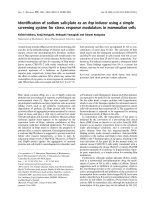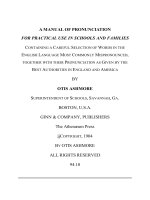A robust music estimator for polynomial phase signals in alpha stable noise
Bạn đang xem bản rút gọn của tài liệu. Xem và tải ngay bản đầy đủ của tài liệu tại đây (587.12 KB, 4 trang )
➠
➡
A ROBUST MUSIC ESTIMATOR FOR POLYNOMIAL PHASE SIGNALS IN α-STABLE
NOISE
Mounir DJEDDI, Hocine BELKACEMI, Messaoud BENIDIR, Sylvie MARCOS
Laboratoire des signaux et syst`emes (L2S)
Sup´elec, 3 rue Joliot-Curie 91190 Gif-sur-Yvette (France)
ABSTRACT
In this paper, we address the problem of estimation of the parameters of mono and multicomponent Polynomial Phase Signals (PPS)
affected by alpha-stable noise using subspace methods. We propose two new estimators : a modified multiple signal classification
MUSIC for PPS affected by Gaussian noise, and a modified robust MUSIC algorithm for PPS based on fractional lower-order
statistics (FLOS). Simulation results show that the robust MUSIC
estimator is able to estimate the values of the phase parameters in
impulsive environment hence outperforming the standard estimators.
which handle robustly the presence of heavy-tailed noise in the
data .
This paper is organized as follows. In section 2, we briefly review the model of PPS. Then in sections 3, we present the model
of complex α-stable noise. In section 4,we introduce our FLOS
based subspace method for the estimation of PPS in impulsive
noise. Some simulation examples are presented in section 5. Concluding remarks are given in Section 6.
2. THE POLYNOMIAL PHASE SIGNAL MODEL
The constant amplitude polynomial phase signal of order M is
given by
1. INTRODUCTION
M
Constant amplitude polynomial phase signals (PPS) are commonly
used in many fields of engineering such as radar, sonar and telecommunications [1]. Many algorithms have been proposed in literature
for the analysis of PPS. Non-parametric methods relying on timefrequency analysis tools such Polynomial Phase Wigner-Ville Distribution(PWVD) has been extensively used for the instantaneousfrequency (IF) estimation, as well as parametric methods such as
the polynomial phase transform for the estimation of the parameters of the phase. In many practical situations, the signal under
consideration may be subjected to additive noise which is assumed
to be Gaussian. Several papers have considered this case as in [2].
However, the assumption of Gaussianity is not valid in some cases
when noise is generated from atmospheric or underwater acoustic
phenomena which displays impulsive characteristics with heavytailed distributions that degrade significantly the signal. Impulsive
noise can be modeled by α-stable random process. The fact that
α-stable random variables with α < 2 have infinite second moment means that many techniques based on second order statistics
(SOS) do not apply, and therefore, we must consider other alternatives to mitigate the effect of the non-Gaussian impulsive noise. In
[3] we proposed a robust FLOS based PWVD for IF representation
of PPS in α-stable noise. Recently some subspace methods have
been proposed to analyse PPS. In [4], the authors derived a Capon
form of the wigner distribution and polynomial periodogram. In
[5], the author extended the Capon estimator to the analysis of
PPS by considering a time-dependent autocorrelation sample estimates of the nonstationary signal. In [6] the MUSIC algorithm has
been applied for parameter estimation of PPS in Gaussian noise
by transforming the phase to a linear phase using the polynomial
phase transform.
In this paper, we propose a robust MUSIC estimator for PPS of
order higher than 2 corrupted by additive α-stable impulsive noise
using Fractional Lower-Order Statistics (FLOS) introduced in [7]
0-7803-8874-7/05/$20.00 ©2005 IEEE
s(n) = A exp {jφ(n)} = A exp
j
ai ni
(1)
i=0
where A is the amplitude of the signal, the ai ’s (i = 0, . . . , M )
are the phase coefficients; assumed real and unknown.
The instantaneous frequency (IF) is defined as
M
fi (n) =
1
1 dφ(n)
=
i ai ni−1 .
2π dt
2π i=1
(2)
3. COMPLEX α STABLE NOISE
There exists many physical processes generating interference containing noise components that are impulsive in nature (e.g., atmospheric noise in radio links; and radar reflections from ocean
waves, and reflections from large, flat surfaces including buildings and vehicles). The amplitude distributions of such returns
are not Gaussian, and tend to produce large-amplitude excursions
and occasional bursts of outlying observations. Impulsive noise
profoundly degrades the performance of standard algorithms and
produce poor results.
In our case, the impulsive noise is modeled by complex α stable
signal X = X1 + jX2 which is better defined by its characteristic
function [8]
ϕ(t) = E{exp[j (tX ∗ )]} = E{exp[j(t1 X1 + t2 X2 )]}
(3)
where t = t1 + jt2 . X is called isotropic SαS if (X1 , X2 ) has a
uniform spectral measure [8]. In this case, the characteristic function reduces to
ϕ(t) = E{exp [j (tX ∗ )]} = exp(−γ |t|α )
(4)
The stable distribution is completely characterized by the parameters α (0 < α ≤ 2) named the characteristic exponent, γ is the
IV - 469
ICASSP 2005
➡
➡
dispersion (γ > 0). The characteristic exponent determines the
shape of the distribution. The smaller α is, the heavier the tails of
the alpha stable density. We should also note that for α = 2 the
distribution coincides with the Gaussian density. The dispersion γ
determines the spread of the distribution in the same way that the
variance of a Gaussian distribution determines the spread around
the mean [7]. For α-stable processes only the moments of order
r < α exist. So estimation methods based on second order statistics of the data cannot be applied. Through out this paper the value
of α is assumed known.
4. TIME-COEFFICIENT REPRESENTATIONS FOR THE
ANALYSIS OF PPS
The multicomponent signal is modeled by the sum of K PPS
x(n) = y(n) + w(n)
K
k=1
=
with
(5)
sk (n) + w(n) 0 ≤ n ≤ N − 1
(6)
sk (n) = Ak ejφk (n)
(7)
4.1. Capon’s estimator for PPS analysis
In [5], a modified Capon method is proposed for noiseless multicomponent PPS analysis, where the signal is passed through a
time-varying filter of order p, so that only one particular PPS is
selected and the others are suppressed. The output signal is given
by
z(n) =
h(n, m)x(m) = hT (n)x(n)
(8)
m=n−p
where h(n) is the impulse response of the filter
h(n) = [h(n, n), h(n, n − 1), . . . , h(n, n − p)]T
(9)
and x(n) is the short-time signal vector
x(n) = [x(n), x(n − 1), . . . , x(n − p)]
4.2. MUSIC estimator for PPS in Gaussian noise
If we consider that w(n) is Gaussian noise, and by following the
same procedure as in [5] with kernel function vector given in (12)
we propose the MUSIC estimator. Using the vector x(n) in (10),
we can write
x(n) = Bs(n) + w(n)
(14)
where
(10)
s1 (n),
...,
sK (n)
T
(15)
bp (n, β1 ),
...,
bp (n, βK )
(16)
...,
w(n − p)
(17)
s(n) =
B=
where the Ak are constant amplitudes, φk are modeled as in (1)
and the w(n) is the additive noise.
n
where Rx,p (n) = E{xH (n)x(n)} is the time-dependent autocorrelation of x(n).
In [9], the authors showed that the spectrogram and the Capon
estimator have the same performance in terms of resolution and
estimation of the instantaneous frequency of mono and multicomponent signals. However, the Capon estimator can have a better
concentration in time-frequency plane. This property is still valid
in the case of PPS parameter estimation.
and the noise vector
w(n) =
w(n),
It can be shown that the covariance matrix can be decomposed
into two subspaces : signal and noise subspaces [10]. The MUSIC
estimator can be written as
PM U SIC (n, β) =
1
H
bH
p (n, β)Ex,p Ex,p bp (n, β)
(18)
where Ex,p = [eK+1 eK+2 . . . ep ] is obtained by performing the
eigendecomposition on the covariance matrix Rx,p (n) and retaining eigenvectors vectors associated to the smallest p − K eigenvalues of the covariance matrix.
The autocorrelation matrix in equation (13) is singular, the problem of inversion can be solved by using diagonal loading ([5], eq.
12) which leads to an additional parameter to be determined. The
use of matrix decomposition allows to solve this problem. On the
other hand, it is possible to reduce the computational complexity of the MUSIC estimator by using algorithms to estimate the
noise subspace without eigendecomposition such as the propagator method.
jφ(n)
Then for an input signal with phase term e
, the transfer function of the filter which can be viewed as the extension of the Zadeh’s
generalized transfer function to PPS is given by
n
H(n, β) =
h(n, m)e−j[φ(n)−φ(m)] = hT (n)bp (n, β)
m=n−p
The vector bp (n, β) is given by
(11)
bp (n, β) = [1, e−j[φ(n)−φ(n−1)] , . . . , e−j[φ(n)−φ(n−p)] ]T (12)
r
where φ(n) = R
r=0 βr n is polynomial phase kernel functions
and β is the coefficient vector β = (β1 , β2 , . . . , βR ). Minimizing
the power at the filter output subject to the constraint that the signal
of interest is passed undistorted, i.e. H(n, β) = 1, one obtains the
time-coefficient representation (TCR) [5]
PCap (n, β) =
1
−1
bH
(n,
β)R
(n)bp (n, β)
x,p
p
4.3. Proposed FLOM-MUSIC as an estimator of PPS in impulsive noise
Many papers have treated the problem of direction of arrival estimation (DOA) in the presence of impulsive noise. algorithms like
ROC-MUSIC and FLOM-MUSIC have been introduced in [8, 11].
We propose to modify the above MUSIC estimator in (18) to estimate the parameter of PPS in impulsive α-stable. In following
we consider only FLOM-MUSIC [11]. Assuming that the noise
w(n) in (6) is impulsive with α stable distribution, the second order statistics (SOS) can not be applied. In this case the covariation
matrix for α-stable processes is equivalent to the covariance matrix
in the case of gaussian noise. In this paper we consider 1 < α ≤ 2.
For α < 1, one can use the zero-memory nonlinearity to clip the
impulsive noise [12].
The (i, j)th element of the covariation matrix C are obtained using
the vector in (10) as defined in [11]
(13)
IV - 470
Cx,p (i, j) = E{x(i)|x(j)|r−2 x∗ (j)}
(19)
➡
➡
250
250
200
200
C = BΛB H + δI
150
150
Time
(20)
where B is defined in (16). Λ, and δ can be derived from ([11],
theorem 2). The robust time-coefficient representation is given as
follows
PF LOM −M U SIC (n, β) =
1
H
bH
p (n, β)E x,p E x,p bp (n, β)
Time
where the value of the fractional moment r must satisfy the following inequality 1 < r < α ≤ 2, so the matrix C is bounded and
can be written using (14) in the form [11]
100
100
50
50
(21)
0
20
40
60
Radian phase−coefficient index
80
100
0
20
40
60
Radian phase−coefficient index
(a)
where E x,p = [eK+1 eK+2 . . . ep ] is obtained by performing the
SVD on the matrix C and retaining the left singular vectors associated to the smallest p − K singular values of C.
80
100
(b)
Fig. 2. (a): MUSIC and (b): FLOM-MUSIC estimators of fourth
order PPS in α-stable noise with α = 1.2 and γ = 1
250
5. SIMULATION RESULTS
200
In this section, we will demonstrate the performance gains when
using fractional lower order statistics. In our simulations, we used
signals of order M = 4 and kernel function phases φ(n) = (π/255)kn4 ,
with 0 ≤ k ≤ 100. The filter order p = 50. First, we consider a
monocomponent PPS as given below
j(10π/255)n4
0 ≤ n ≤ 63
64 ≤ n ≤ 254
e
,
4
ej(50π/255)n , .
x(n) =
Time
150
100
50
(22)
0
20
40
60
Radian phase−coeff. index
80
100
Fig. 3. Capon estimator for two fourth order PPS
Figure 1 shows the Capon estimator for the fourth order noiseless
PPS. Now, we consider a complex SαS noise with the following
250
representation. On the other hand, increasing the value of the dispersion γ beyond value 3 (GSNR=-5dB) with worst case α = 1.01
leads to a degraded TCR. The GSNR is defined according to [8]
200
Time
150
100
GSN R = 10 log
50
0
10
20
30
40
50
60
70
80
90
1
γN
N −1
|s(n)|2
(23)
n=0
100
Radian phase−coefficients
Fig. 1. Capon estimator for the fourth order PPS
4
250
200
200
150
150
Time
250
Time
parameters α = 1.2, γ = 1. Figure 2(a) shows the effect of
the implusive noise on the MUSIC estimator. Using the proposed
FLOM-MUSIC with fractional moment r = 1.1, we can distinguish the two rays corresponding to the value of the phase parameters as shown in figure 2(b).
Now, we consider a two-component fourth order polynomial phase
signal whose Capon time-coefficient representation is shown in
figure 3.
100
100
50
4
50
x(n)) = ej(10π/255)n + ej(50π/255)n , 0 ≤ n ≤ 254
Fig. 2(b) shows again the outperforming results of FLOM-MUSIC
w.r.t. standard algorithms illustrated in figures 4(a) and 4(b).
From simulations, the choice of the order of the filter p is important, an example in figure (6) shows the TCR for p = 10 and
p = 30. We observe that increasing the value of p gives better
0
20
40
60
80
Radian phase−coeff. index
(a)
100
0
20
40
60
80
Radian phase−coeff. index
100
(b)
Fig. 4. (a): Capon and (b): MUSIC estimator of two fourth order
PPS in α-stable noise with α = 1.2 and γ = 1
IV - 471
➡
➠
250
alpha-stable noise,” Acoustics, Speech, and Signal Processing ICASSP ’04, May 2004.
200
[4] V. Katkovnik and L. Stankovic, “High-resolution dataadaptive time-frequency analysis,” 9th International Conference on Electronics, Circuits and Systems, vol. 3, pp. 1023–
1026, Sept. 2002.
¨
[5] M.T. Ozgen,
“Extension of the capon’s spectral estimator to
time-frequency analysis and to the analysis of polynomialphase signals,” Signal processing, vol. 83, no. 3, pp. 575–
592, March 2003.
Time
150
100
50
0
10
20
30
40
50
60
70
Radian phase−coefficient index
80
90
100
250
250
200
200
150
150
Time
Time
Fig. 5. FLOM-MUSIC estimator for two fourth order PPS in αstable noise with α = 1.2 and γ = 1
100
100
50
50
0
20
40
60
80
Radian phase−coeff. index
100
0
[6] G. Zhou, G. B. Giannakis, and A. Swami, “On polynomial
phase signals with time-varying amplitude,” IEEE Trans. on
Signal Processing, vol. 44, no. 4, pp. 848–861, Apr. 1996.
[7] M. Shao and C. L. Nikias, “Signal processing with fractional lower order moments: stable processes and their applications,” Proceedings of the IEEE, vol. 81, Issue: 7, pp.
986 –1010, July 1993.
[8] P. Tsakalides and C. L. Nikias, “The robust covariation-based
music (roc-music) algorithm for bearing estimation in impulsive noise environments,” IEEE Trans. on Signal Processing,
vol. 44, no. 7, pp. 1623–1633, July 1996.
20
40
60
80
Radian phase−coeff. index
(a)
[9] L. Stankivi´c, V. Popovi´c, and M. Dakovi´c, “On the capon’s
method application in time-frequency analysis,” Proc. of the
3rd IEEE International Symposium on Signal Processing and
Information Technology, pp. 721–724, Dec. 2003.
100
(b)
Fig. 6. FLOM-MUSIC for two different values of the filter order
(a): p = 10, (b): p = 30
6. CONCLUSION
In this paper, we reviewed a new time-coefficient representation
(TCR) for polynomial phase signals. We proposed to use the MUSIC algorithm to estimate the values of the parameters of the phase
of PPS affected by Gaussian noise. From simulation we showed
that impulsive noise degrades considerably the TCR as it is the
case for time-frequency representation (TFR). In order to attenuate
the effect of impulsive noise, we proposed a Fractional Lower Order Moment based MUSIC to estimate these parameters for PPS
affected by impulsive α-stable noise. From simulations, we observed that the approaches considered in this paper performed significantly better than the standard algorithms. Future work, we
can reduce the computational complexity of the MUSIC algorithm
by using recently developed techniques in array processing which
compute the noise subspace without SVD or eigendecomposition.
[10] S. M. Kay, “Modern spectral estimation, theory and application,” Prentice-Hall Signal Proc. Series, 1987.
[11] Tsung-Hsien Liu and J. M. Mendel, “A subspace-based direction finding algorithm using fractional lower order statistics,” IEEE Trans. on Signal Processing, vol. 49, no. 8, pp.
1605–1633, August 2001.
[12] A. Swami and B. Sadler, “Tde, doa, and related parameter estimation problems in impulsive noise,” In Proc. IEEE
Signal Processing Workshops Higher order Stat., , no. 4, pp.
848–861, July 1997.
7. REFERENCES
[1] S. Barbarossa, A. Scaglione, and G. B. Giannakis, “Product high-order ambiguity function for multicomponent
polynomial-phase signal modeling,” IEEE Trans. on Signal
Processing, vol. 46, pp. 691–708, March 1998.
[2] M. Benidir and A. Ouldali, “Statistical analysis of polynomial phase signals affected by multiplicative and additive
noise,” Signal processing, vol. 78, N1, pp. 19–42, 1999.
[3] M. Djeddi and M. Benidir, “Robust polynomial wigner-ville
distribution for the analysis of polynomial pahse signals in
IV - 472









